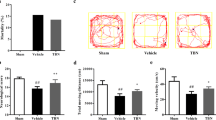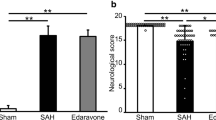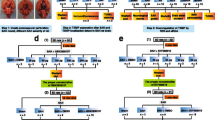Abstract
Background
The exact underlying pathogenic mechanisms and effective preventive or therapeutic interventions for cerebral vasospasm remain obscure. The thioredoxin (Trx) system performs important functions in the central nervous system including neurotrophic and neuroprotective actions. There is no study directly investigating the effects of subarachnoid hemorrhage (SAH) induced cerebral vasospasm on the Trx system in the literature.
Methods
Sixteen male New Zealand rabbits were randomly divided into two groups of eight rabbits each: a control group and a SAH group. The control group, (n = 8) was a sham surgery group in which SAH was not induced. In the SAH group, (n = 8), the SAH protocol was used to induce cerebral vasospasm. The brain and brainstem were removed and each brainstem was cut coronally into two pieces: an anterior part that contains basilar artery and a dorsal part that contains brainstem tissue. The brainstem tissue thioredoxin-1(Trx1), thioredoxin-2 (Trx2), thioredoxin reductase (TrxR), thioredoxin reductase-1 (TrxR1), thioredoxin-interacting protein (TXNIP) levels were investigated. Total oxidant status (TOS), total antioxidant status (TAS), malondialdehyde levels (MDA) and tumor necrosis factor alpha (TNF-alpha) levels were investigated for determining the oxidative-antioxidative status of the related brain tissues. Basilar artery segments were investigated for cross-sectional area and wall thickness measurements.
Results
SAH statistically significantly reduced the tissue levels of Trx1 (p < 0.01) and TrxR (p < 0.01). Trx2 levels were not significantly altered after SAH (p > 0.05). SAH significantly reduced the expression of TrxR1 (p < 0.01) and significantly increased the expression of TXNIP (p < 0.01) when compared with controls. TOS levels and MDA levels significantly increased after SAH (p < 0.01) and TAS levels significantly reduced after SAH (p < 0.01). TNF-alpha levels significantly increased after SAH (p < 0.01). SAH-induced cerebral vasospasm significantly (p < 0.05) increased the wall thickness and reduced the mean cross-sectional area of the basilar artery (p < 0.05).
Conclusions
The Trx system seems to be negatively affected by the simultaneously interrelated enzymatic alterations during cerebral vasospasm.



Similar content being viewed by others
References
Ayer RE, Zhang JH (2008) Oxidative stress in subarachnoid haemorrhage: significance in acute brain injury and vasospasm. Acta Neurochir 104:33–41
Dorsch NW (1995) Cerebral arterial spasm—a clinical review. Br J Neurosurg 9(3):403–412
Dumont AS, Dumont RJ, Chow MM, Lin CL, Calısaneller T, Ley KF, Kassell NF, Lee KS (2003) Cerebral vasospasm after subarachnoid hemorrhage: putative role of inflammation. Neurosurgery 53(1):123–133
Erdi MF, Guney O, Kiyici A, Esen H (2011) The effects of alpha lipoic acid on cerebral vasospasm following experimental subarachnoid hemorrhage in the rabbit. Turk Neurosurg 21(4):527–533
Güney O, Erdi F, Esen H, Kiyici A, Kocaogullar Y (2010) N-acetylcysteine prevents vasospasm after subarachnoid hemorrhage. World Neurosurgery 73(1):42–49
Haapasalo H, Kylaniemi M, Paunul N, Kinnula VL, Soini Y (2003) Expression of antioxidant enzymes in astrocytic brain tumors. Brain Pathol 13(2):155–164
Järvelä S, Bragge H, Paunu N, Jarvela T, Paljarvi L, Kalimo H, Helen P, Kinnula V, Soini Y, Haapasalo H (2006) Antioxidant enzymes in oligodendroglial brain tumors: association with proliferation, apoptotic activity and survival. J Neurooncol 77(2):131–140
Kemerdere R, Kacira T, Hanimoglu H, Kucur M, Tanriverdi T, Canbaz B (2013) Tissue and plasma thioredoxin reductase expressions in patients with glioblastoma multiforme. J Neurol Surg A Cent Eur Neurosurg 74(4):234–238
Kim GS, Jung JE, Narasimhan P, Sakata H, Chan PH (2012) Induction of thioredoxin-interacting protein is mediated by oxidative stress, calcium, and glucose after brain injury in mice. Neurobiol Dis 46(2):440–449
Kolias AG, Sen J, Belli A (2005) Pathogenesis of cerebral vasospasm following aneurysmal subarachnoid hemorrhage: putative mechanisms and novel approaches. J Neurosci Res 87(1):1–11
Lappalainen Z, Lappalainen J, Oksala NK, Laaksonen DE, Khanna S, Sen CK, Atalay M (2009) Diabetes impairs exercise training-associated thioredoxin response and glutathione status in rat brain. J Appl Physiol 106(2):461–467
Ma YH, Su N, Chao XD, Zhang YQ, Zhang L, Han F, Luo P, Fei Z, Qu Y (2012) Thioredoxin-1 attenuates post-ischemic neuronal apoptosis via reducing oxidative/nitrative stress. Neurochem Int 60(5):475–483
Ohkawa H, Ohishi N, Yagi K (1979) Assay for lipid peroxides in animal tissues by thiobarbituric acid reaction. Anal Biochem 95(2):351–358
Patenaude A, Murthy MR, Mirault ME (2005) Emerging roles of thioredoxin cycle enzymes in the central nervous system. Cell Mol Life Sci 62(10):1063–1080
Takagi Y, Horikawa F, Nozaki K, Sugino T, Hashimoto N, Yodoi J (1998) Expression and distribution of redox regulatory protein, thioredoxin during transient focal brain ischemia in the rat. Neurosci Lett 251(1):25–28
Takagi Y, Tokime T, Nozaki K, Gon Y, Kikuchi H, Yodoi J (1998) Redox control of neuronal damage during brain ischemia after middle cerebral artery occlusion in the rat: immunohistochemical and hybridization studies of thioredoxin. J Cereb Blood Flow Metab 18(2):206–214
Tian L, Nie H, Zhang Y, Chen Y, Peng Z, Cai M, Wei H, Qin P, Dong H, Xiong L (2014) Recombinant human thioredoxin-1 promotes neurogenesis and facilitates cognitive recovery following cerebral ischemia in mice. Neuropharmacology 77:453–464
Yagublu V, Arthur JR, Babayeva SN, Nicol F, Post S, Keese M (2011) Expression of selenium-containing proteins in human colon carcinoma tissue. Anticancer Res 31(9):2693–2698
Yoshihara E, Masaki S, Matsuo Y, Chen Z, Tian H, Yodoi J (2014) Thioredoxin/txnip: redoxisome, as a redox switch for the pathogenesis of diseases. Frontiers Immun 4:514
Zhou F, Liu PP, Ying GY, Zhu XD, Shen H, Chen G (2013) Effects of thioredoxin-1 on neurogenesis after brain ischemia/reperfusion injury. CNS Neurosci Ther 19(3):204–205
Acknowledgments
This study was supported by Necmettin Erbakan University Scientific Research Projects Office (Project No: 131218018)
Conflict of interest
The authors declare that they have no conflict of interest.
Author information
Authors and Affiliations
Corresponding author
Additional information
Comment
This is an interesting research, conducted in an already well-described rabbit model of SAH, and compared to sham operated controls. The primary objective of the study is the quantification, in the brainstem tissue, of the levels of thioredoxin-related proteins Trx1, Trx2, TrxR, TrxR1, TXNIP 72 h after SAH. Because the authors attempted to correlate changes in these proteins with the occurrence of cerebral vasospasm, they have simultaneously quantitatively analyzed five cross-sectional basilar artery segments measuring its wall thickness. As a secondary endpoint, in order to determine the oxidative-antioxidative status of these brain areas, they have assessed quantitatively the levels of the oxidative stress proteins TOS, TAS, MAD, and TNF-alpha. The major problem with this research is establishing a link between these three aims. SAH induces a global brain dysfunction, at various levels, and different interrelated enzymatic systems are consequently altered. For this, it is a complex disease. It remains to be elucidated if the alterations in the Trx system are a direct consequence of vasospasm instead of being a part of the simultaneously interrelated synchronous dysfunction post SAH. The Trx system seems to be negatively affected from the alterations after SAH. Although it has complex neuroprotective, neurotropic, ROS scavenging, and signal transduction effects, the alterations of the Trx system during vasospasm merit further investigations.
Domenico d'Avella and Antonino Germanò
Padova and Messina, Italy
Rights and permissions
About this article
Cite this article
Kaya, B., Erdi, F., Kılınc, I. et al. Alterations of the thioredoxin system during subarachnoid hemorrhage-induced cerebral vasospasm. Acta Neurochir 157, 793–800 (2015). https://doi.org/10.1007/s00701-015-2390-z
Received:
Accepted:
Published:
Issue Date:
DOI: https://doi.org/10.1007/s00701-015-2390-z




